Filing papers and documents before the digital era

Before we went digital around the late 1950s and early 1960s, documents had to be kept on paper. In order to locate them quickly, they had to be filed in an organised manner that made them easy to retrieve. This page describes the huge problems of this type of filing; along with storage in filing cabinets and index boxes. Also discussed are filing systems for storing very large amounts of material.
____
By the webmaster, who frequently had to use pre-digital filing systems
What keyword to file a document under?
Filing had to be according to some sort of keyword, not that the term 'keyword' was ever used. Normal terminology was filing 'under' a particular word or set of words. Dates and names were common such keywords, but with non-digital filing any one item could only be assigned one keyword. Too often, identifying a suitable keyword was a hit and miss affair because what the person filing thought would be most suitable was not what the person trying to retrieve assumed would be the keyword.
Would you, for example, file documents about mending a tap under 'taps', 'date of mending', surname of plumber, 'bathrooms' etc? You could only choose one of them. (This is why the digital age with its databases and spreadsheets are so superior because items can be assigned a number of keywords and searched on any one of them.)
Documents frequently got lost, simply because of ambiguous filing.
Why so many errors with pre-digital filing
Filing was time-consuming and boring and, as explained below, it couldn't be done while sitting in one place. The task was frequently given to temporary staff who had no idea what keywords to assign to any document. They had little interest in the long-term life of their filing as they would shortly move on, and, anyway, they knew it was impossible to do a good job however hard they tried. The range of apparently suitable keywords was too great.
Companies cherished long-term secretaries who understood their own filing systems.
Filing cabinets for storing standard size documents
Most of the documents that needed filing were of the standard paper size. In the past, the paper was 'foolscap' which was slightly longer than A4.
The standard way of filing these documents was in a filing cabinet, like the ones in the photos below. The wooden ones were rather more up-market than the metal ones.
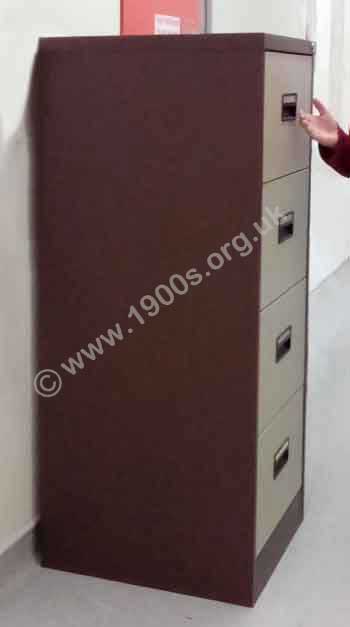
Wooden filing cabinet
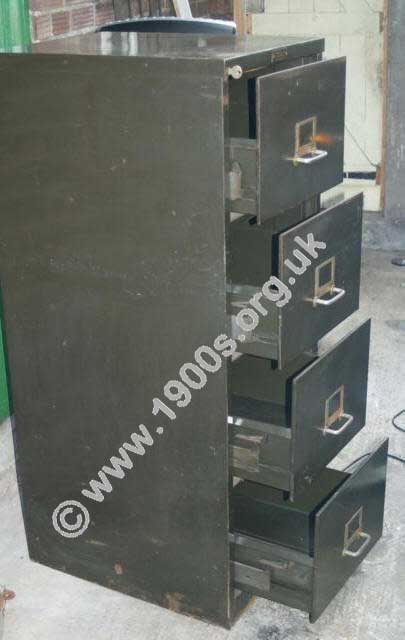
Metal filing cabinet with its drawers open
Most offices had sets of such filing cabinets with rows and columns of drawers as shown in the pictures.
So the act of filing meant to-ing and fro-ing from one drawer to another, bending down, and then returning to a desk or table where the papers to be filed were spread out. That is why it couldn't be done while sitting at a desk.
Retrieving was equally laborious and time-consuming.
Labels on filing cabinet drawers
On the front of each drawer, by its handle, were slots for removable cards showing the range of items stored in that particular drawer, for example D-F or 53-55 or dates, etc. Frequently the cards needed to be removable because some drawers got filled more quickly than others so that the contents had to be shifted along. Then new cards needed to be made to show the new contents of the drawer.
A look inside filing cabinet drawers
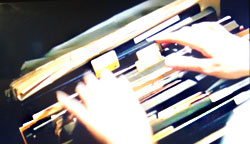
Searching inside a filing cabinet drawer
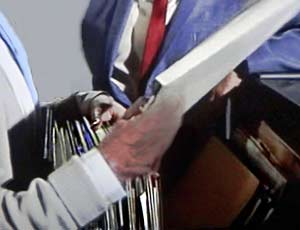
Inside a filing cabinet drawer
Inside each drawer of a filing cabinet were 'slots' of folded cardboard hung from horizontal metal strips.
The strips slid on runners so that any one slot could easily be opened up for viewing or retrieval. The horizontal strips had small holders for strips of paper to show the contents of the slot. Documents with the same keyword were filed together in the same slot, normally with the most recent addition on top. The photos give the idea.
Specialist filing cabinets
The two styles of filing cabinet described above were certainly the most common, but filing cabinets of different size bodies and different sized drawers were also made for specialist needs.
Index card filing systems
Cards, known as index cards were used for storing compact information such as contact details of customers or locations of bulky items.
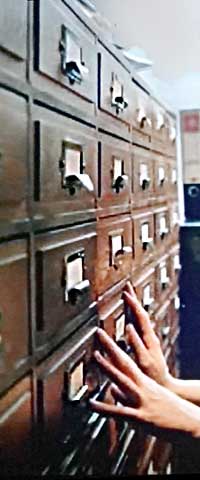
Card index cabinet
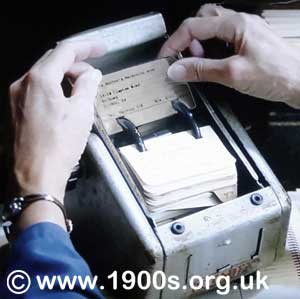
Card index desk box
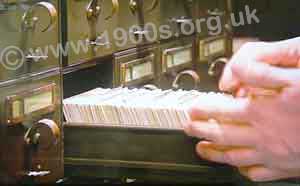
Card index system in use
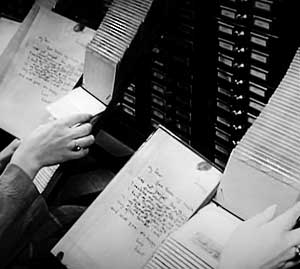
Working with card index systems
Cabinets for card indexes looked from the outside rather like small versions of the larger filing cabinets already described. The drawers were of course smaller to take small index cards and often a single box of just one drawer was all that was required. People often kept a small card index box on their desk.
Systems for filing and retrieving large amounts of material
With very large amounts of material, you really had to know your way around in order to retrieve something. I shall never forget trying to find a document in what was then the Public Record Office and is now the National Archives. This was before the stock was digitised.
I was trying to find the seaman's record for one of my ancestors. The process took a very long time because the first index system merely narrowed the search and directed to a second index system which narrowed it a third and so on. Each index system was located in a different place.
I can't remember the procedure exactly, so my apologies to the National Archives as I have surely got it wrong in detail, but it was something like:
In Navy records go to Type of service
Knowing Type of service go to Century in another filing cabinet
Knowing Century go to Year in another filing cabinet
Knowing Year go to Ship in another filing cabinet
Knowing Ship go to Seaman in another filing cabinet
Knowing Seaman go to First letter of seaman's surname in another filing cabinet
etc.
The whole process was time-consuming and frustrating. We must be thankful for computerised records!
| sources | webmaster | contact |
Text and images are copyright
If you can add anything to this page or provide a photo, please contact me.



